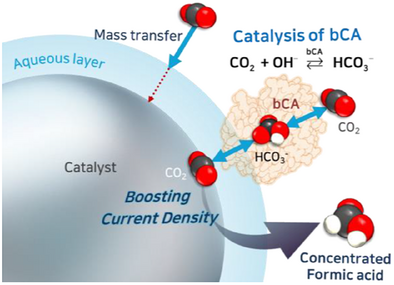Boosting Current Density of Electrocatalytic CO2 Reduction using Metal–Enzyme Hybrid Cathodes
Graphical Abstract
A metal-enzyme (M-bCA) hybrid platform integrates highly stabilized and densely loaded bovine carbonic anhydrase (bCA) immobilized on CNTs with Sn and Bi catalysts. The enzyme dynamically catalyzes the reversible interconversion between CO2 and bicarbonate, enabling rapid local CO2 regeneration at the catalyst surface. This enhanced CO2 supply boosts CO2RR current densities beyond mass transfer limits.
Abstract
As a promising solution to global warming, electrocatalytic reduction of carbon dioxide (CO2RR) to liquid fuel has attracted great attention. A primary challenge in industrializing CO2RR technologies for producing liquid fuel is the mass transfer limitation of CO2, which significantly reduces the current density of CO2RR. This study proposes a new enzyme-enhanced electrocatalysis platform for boosting CO2RR current density. This platform integrates an enzyme of bovine carbonic anhydrase (bCA), stabilized on carbon nanotubes (bCA@CNT), into formate/formic acid selective metal catalysts such as tin (Sn) and bismuth (Bi) to prepare Metal-bCA (M-bCA) hybrid cathodes. The incorporation of bCA enhances both the CO2 hydration and the reversible dehydration of bicarbonate to CO2 in the cathode. This dynamic catalysis of bCA facilitates rapid local regeneration of dissolved CO2 from bicarbonate at the catalyst surface, thereby boosting the current density of CO2RR. Consequently, the formate current density of the Sn-bCA cathode was 3.3 times higher than that of the bare Sn cathode in a membrane-electrode assembly (MEA)-type cell. Furthermore, the Bi-bCA cathode achieved an excellent current density of 442 mA cm−2, 1.5 times higher than the bare Bi cathode, for direct production of highly concentrated (3.4 mol L−1) formic acid in a 3-compartment cell.
Conflict of Interests
The authors declare no conflict of interest.
Open Research
Data Availability Statement
The data that support the findings of this study are available from the corresponding author upon reasonable request.





